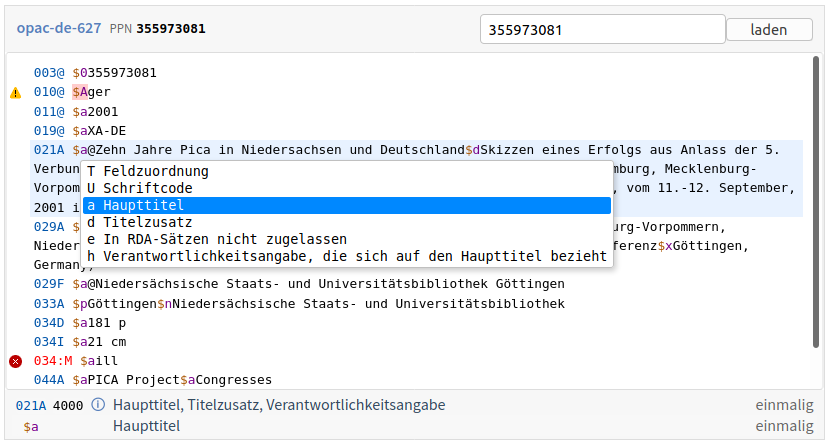Fünf Jahre Avram
zur Beschreibung und Validierung von Bibliotheksdaten
2024-04-15
Warum Avram?
Beschreibung von Katalogformaten nicht maschinenlesbar:
- MARC21 (Bibliographic, Authority…)
- K10plus PICA
- GND-PICA
- …
Lokale Anwendungsprofile von Katalogformaten
Prüfung von Daten schwer reproduzierbar
Umständliches Nachschlagen in PDF/HTML-Dokumentation
Wie kam es zu Avram?
Vorarbeiten von Péter Király mit dem Metadata Quality Assurance Framework (ab 2015)
Statistik von MARC21-Feldern (Herbst 2017, Karen Coyle)
Wunsch nach maschinenlesbarer Liste (Januar 2018)
Umsetzung von Validatoren in Java und Perl für MARC21 und PICA (Péter, ich und Johann Rolschewski)
Avram Spezifikation 0.1.0 (Februar 2018)
Henriette Avram

- 1919 New York – 2006 Miami
- 1941-1951 Heirat und Kinder
- 1951 Studium der Mathematik
- 1952-1959 Arbeit bei der NSA
- 1965 Leiterin des Project MARC
- bis 1992 and der LoC
Die Avram Spezifikation
Aufgaben einer Schema-Sprache
Formale Schemas definieren Formate
Gleiche Validierung mit verschiedenen Programmen
Dokumentation
Aufgaben einer Schema-Sprache
Informationen in Avram-Schemas
Welche Felder gibt es?
Welche Unterfelder gibt es?
Welche davon sind optional und wiederholbar?
Metadaten (Namen, Beschreibung, Änderungsdatum, Links auf Dokumentation…)
Beispiel (MARC21)
Validierung von Feldinhalten
Codeliste erlaubter Werte (z.B. ISO-Sprachcodes)
Regulärer Ausdruck
Positionen
Beispiel-Feld (MARC21)
{
"tag": "033",
"label": "Date/Time and Place of an Event",
"url": "https://www.loc.gov/marc/bibliographic/bd033.html",
"subfields": {
"a": {
"label": "Formatted date/time",
"repeatable": true,
"pattern": "^[0-9-]{8}([0-9]{4}([+-][0-9]{4})?)?$"
},
"2": {
"label": "Source of term",
"repeatable": true,
"codes": "https://www.loc.gov/standards/sourcelist/subject.html",Zusätzliche Möglichkeiten
Markierung von Elementen als
deprecatedRecord Types
Erweiterung durch Verweis auf externe Regeln
Statistik: Wie oft kommen (Unter)felder vor?
Was kann Avram nicht?
Datentypen (Zahl, Datum…)
Wenn-dann-Regeln
Interpretation des Inhalts
Avram in der Praxis
Vorhandene Avram-Schemas
- MARC21 via https://github.com/timathom/marc-schema/
- MARC21 via https://github.com/sul-dlss-labs/marctable
- MARC21 via QA Catalogue
- UNIMARC erstellt per Hand (für QA Catalogue)
- PICA+ (K10plus) via K10plus-Formatdatenbank
- Anwendungsprofile
QA Catalogue
Erstes Validierungstool
Primär für MARC21, inzwischen auch PICA und UNIMARC
Backend: Analyse-Skript und Solr-Index (auch via Docker)
Frontend: Webinterface für Ergebnisse

Catmandu
Kommandozeilen-Werkzeug zur Datenkonvertierung
picadata
Grundlage von Catmandu::Validator::PICA
Konvertierung und Validierung von PICA+
Fehler in Datensätzen auch als Annotation möglich
Beispiel
Avram-JS
Referenzimplementierung (d.h. alle Features)
Validierung von MARC, PICA und CSV
Prüfung von Avram-Schema-Dateien (!)
Beispiel
PicaEditor

PicaEditor
Anzeige von PICA-Datensätzen mit Syntax-Highlighting und Kontexthilfe
Eher Proof of Concept
Problem: Pica3 vs. PICA+
Online-Demo ist grade kaputt
Verwandte Methoden
Alternativen zu Avram
JSON \(\Rightarrow\) JSON Schema
XML \(\Rightarrow\) XML Schema, Schematron, RelaxNG
RDF \(\Rightarrow\) SHACL, ShEx
CSV \(\Rightarrow\) Data Package Table Scheme, SQL…
Achtung: RDF/XML, MARCXML… sind nur XML-Verpackungen!
Wann sollte Avram nicht verwendet werden?
Kein MARC oder PICA im Einsatz
Was ich nicht weiß, macht mich nicht heiß
Die Daten werden sowieso nicht genutzt
Zusammenfassung
Avram gibt’s seit 5 Jahren
Validierung und Beschreibung von MARC- und PICA-Daten (und CSV)
Mehrere unabhängige Implementierungen und Schemas
Außer K10plus leider keine offizielle Unterstützung durch Herausgeberinnen von Bibliographischen Formaten (hello, LoC!*)
Ausstehende Verabschiedung der Spezifikation Version 1.0.0 nur Kosmetik
Validierung hilft, Qualität macht aber auch Arbeit
Weitere Informationen
Diese Folien: https://jakobib.github.io/kim2024-avram/
Avram-Spezifikation https://format.gbv.de/schema/avram/specification
PICA-Formate entschlüsseln mit Avram und PicaEditor (2020) https://doi.org/10.5446/48737
